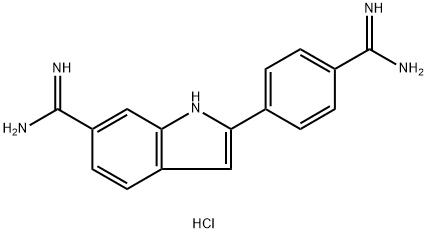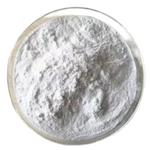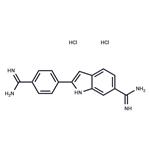Description
DAPI is a fluorescent probe which is commonly used to stain DNA and chromosomes for fluorescent microscopy and flow cytometry applications. It forms a fluorescent complex by attaching in the minor groove of A-
T rich sequences of DNA. DAPI is often used as a counterstain, as its ultraviolet (max 358 nm) excitation and blue (max 461 nm) emission wavelengths separate it nicely from many popular primary fluorophores. It can be used on either fixed or live cells, although its low permeability in live cells demands that higher concentrations be used.
Chemical Properties
Yellow Solid
Uses
Suitable for
- DNA staining in agarose gels
- analysis of changes in DNA during apoptosis
- detection of mycoplasma
- photofootprinting of DNA
- immunofluorescent staining of cells
DAPI has been used:-
- in rapid monitoring of microbial contamination
- in chromosomal banding technique
- in detection of apoptotic cells
- in fluorescence microscopy to track the DisA (DNA integritiy scanning protein) movement on Bacillus subtilis DNA
- to stain mature pollen grains(0.5 mg/ml)
Uses
DAPI is used for photofootprinting of DNA, to detect annealed probes in blotting applications by specifically visualizing the double-stranded complex and as a cell permeable fluorescent minor groove-binding probe for DNA. For staining DNA in agarose gels
Uses
4',6-Diamidino-2-phenylindole dihydrochloride is used as a cell-permeable DNA-binding dye. Binds preferentially to DNA rich in adenine and thymine.It is used in flow cytometry for measuring nuclear DNA content or for sorting isolated chromosomes.
General Description
DAPI, 4′,6-diamidino-2-phenylindole, is a blue fluorescent nucleic acid stain that fluoresces brightly upon selectively binding to the minor groove of double stranded DNA. Its selectivity for DNA and high cell permeability allows efficient staining of nuclei with little background from the cytoplasm. The excitation and emission wavelengths of DAPI-DNA complex are 360 nm and 460 nm, respectively.
Biochem/physiol Actions
Cell permeable fluorescent minor groove-binding probe for DNA. Binds to the minor groove of double-stranded DNA (preferentially to AT rich DNA), forming a stable complex which fluoresces approximately 20 times greater than DAPI alone.
References
[1] W. C. RUSSELL D. H W CAROL NEWMAN. A simple cytochemical technique for demonstration of DNA in cells infected with mycoplasmas and viruses[J]. Nature, 1975, 253 5491: 461-462. DOI:
10.1038/253461a0.
[2] BETTY I. TARNOWSKI James H N F Spinale. DAPI as a useful stain for nuclear quantitation.[J]. Biotechnic & Histochemistry, 1991, 22 1: 297-302. DOI:
10.3109/10520299109109990.
[3] ANA KATRINA ESTANDARTE. The use of DAPI fluorescence lifetime imaging for investigating chromatin condensation in human chromosomes.[J]. Scientific Reports, 2016: 31417. DOI:
10.1038/srep31417.




